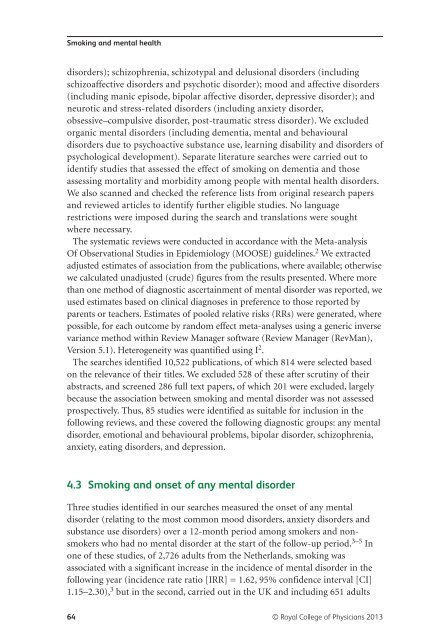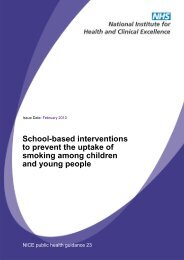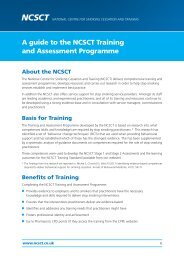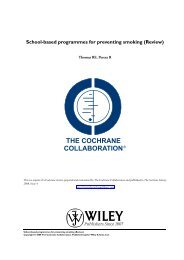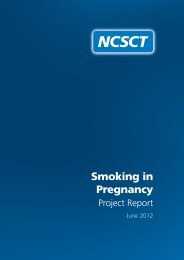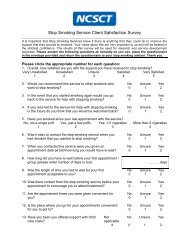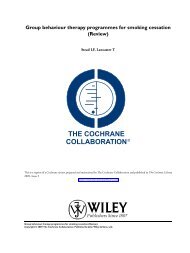Smoking and mental health - NCSCT
Smoking and mental health - NCSCT
Smoking and mental health - NCSCT
You also want an ePaper? Increase the reach of your titles
YUMPU automatically turns print PDFs into web optimized ePapers that Google loves.
<strong>Smoking</strong> <strong>and</strong> <strong>mental</strong> <strong>health</strong><br />
disorders); schizophrenia, schizotypal <strong>and</strong> delusional disorders (including<br />
schizoaffective disorders <strong>and</strong> psychotic disorder); mood <strong>and</strong> affective disorders<br />
(including manic episode, bipolar affective disorder, depressive disorder); <strong>and</strong><br />
neurotic <strong>and</strong> stress-related disorders (including anxiety disorder,<br />
obsessive–compulsive disorder, post-traumatic stress disorder). We excluded<br />
organic <strong>mental</strong> disorders (including dementia, <strong>mental</strong> <strong>and</strong> behavioural<br />
disorders due to psychoactive substance use, learning disability <strong>and</strong> disorders of<br />
psychological development). Separate literature searches were carried out to<br />
identify studies that assessed the effect of smoking on dementia <strong>and</strong> those<br />
assessing mortality <strong>and</strong> morbidity among people with <strong>mental</strong> <strong>health</strong> disorders.<br />
We also scanned <strong>and</strong> checked the reference lists from original research papers<br />
<strong>and</strong> reviewed articles to identify further eligible studies. No language<br />
restrictions were imposed during the search <strong>and</strong> translations were sought<br />
where necessary.<br />
The systematic reviews were conducted in accordance with the Meta-analysis<br />
Of Observational Studies in Epidemiology (MOOSE) guidelines. 2 We extracted<br />
adjusted estimates of association from the publications, where available; otherwise<br />
we calculated unadjusted (crude) figures from the results presented. Where more<br />
than one method of diagnostic ascertainment of <strong>mental</strong> disorder was reported, we<br />
used estimates based on clinical diagnoses in preference to those reported by<br />
parents or teachers. Estimates of pooled relative risks (RRs) were generated, where<br />
possible, for each outcome by r<strong>and</strong>om effect meta-analyses using a generic inverse<br />
variance method within Review Manager software (Review Manager (RevMan),<br />
Version 5.1). Heterogeneity was quantified using I 2 .<br />
The searches identified 10,522 publications, of which 814 were selected based<br />
on the relevance of their titles. We excluded 528 of these after scrutiny of their<br />
abstracts, <strong>and</strong> screened 286 full text papers, of which 201 were excluded, largely<br />
because the association between smoking <strong>and</strong> <strong>mental</strong> disorder was not assessed<br />
prospectively. Thus, 85 studies were identified as suitable for inclusion in the<br />
following reviews, <strong>and</strong> these covered the following diagnostic groups: any <strong>mental</strong><br />
disorder, emotional <strong>and</strong> behavioural problems, bipolar disorder, schizophrenia,<br />
anxiety, eating disorders, <strong>and</strong> depression.<br />
4.3 <strong>Smoking</strong> <strong>and</strong> onset of any <strong>mental</strong> disorder<br />
Three studies identified in our searches measured the onset of any <strong>mental</strong><br />
disorder (relating to the most common mood disorders, anxiety disorders <strong>and</strong><br />
substance use disorders) over a 12-month period among smokers <strong>and</strong> nonsmokers<br />
who had no <strong>mental</strong> disorder at the start of the follow-up period. 3–5 In<br />
one of these studies, of 2,726 adults from the Netherl<strong>and</strong>s, smoking was<br />
associated with a significant increase in the incidence of <strong>mental</strong> disorder in the<br />
following year (incidence rate ratio [IRR] = 1.62, 95% confidence interval [CI]<br />
1.15–2.30), 3 but in the second, carried out in the UK <strong>and</strong> including 651 adults<br />
64 © Royal College of Physicians 2013


